Interrelationship of Electric Double Layer Theory and Microfluidic Microbial Fuel Cells: A Review of Theoretical Foundations and Implications for Performance
Abstract
1. Introduction
2. Review Background
2.1. Microbial Fuel Cells
2.1.1. Architecture
2.1.2. Membraneless Microfluidic Microbial Fuel Cells (MMMFCs)
2.1.3. Microbial Cell Metabolism Reactions
2.1.4. Electron Transfer Reaction
2.1.5. Kinetics
2.2. Fibrous Microfluidic Systems
Current State of Research
2.3. Evolution of the Electric Double Layer in Microfluidic Channels—Site Dissociation Model
2.4. Electric Double Layer of Microbial Systems
2.5. Interrelationship of the Electric Double Layer and Microfluidic Systems
2.5.1. Electrostatics and Hydrodynamics
2.5.2. Electrokinetics of the Flow Regime
2.6. Influence of Electrokinetics on Viscosity
2.6.1. Primary Electroviscous Effect
2.6.2. Apparent Viscosity
2.6.3. Potential and Surface Charge Density Relationships
2.6.4. Fibrous Microfluidic Systems
2.7. Implications for Performance of Microfluidic Microbial Fuel Cells
2.7.1. Electric Double Layer Effect
2.7.2. Relationship with MFC Performance
2.7.3. pH Effect
2.7.4. Effect of Surface Chemistry
2.8. Implications of Hydrodynamics and Electrokinetics on MMFC Performance
2.8.1. Impact of Flow Rate on MMFCs
2.8.2. Impact of Flow Rate on MMFCs
2.8.3. Integrating MFs and MFCs
2.8.4. Summary and Conclusions
- The current review paper is extensive and, above all, it fills the knowledge gap relating to the lack of literature that focuses on the theoretical aspects of microfluidic microbial fuel cells reflecting the fundamental theory of the electrical double layer.
- The electric double layer theory, as found in colloidal science relating to stability, is also directly applicable to microfluidic systems related to microbial fuel cells.
- The potential distribution and the associated electrokinetic flow in streaming potential systems are also applicable to microfluidic fuel cell systems.
- The effect of the streaming potential difference under a pressure gradient flow in electrokinetic systems, relating to the transverse velocity profile, and the electroviscous phenomenon in microfluidic channels are directly applicable to microfluidic microbial fuel cell systems.
- The current review paper clearly establishes a link between the analytical solution of the mean field Poisson–Boltzmann equation and the concept of microfluidic microbial fuel cells, and it will inspire research in this direction.
- The effect of the electric double layer of bacteria is reduced biofilm attachment due to electrostatic repulsion between the negatively charged bacterial cell wall surface and that of carbon-based anodes.
Author Contributions
Funding
Acknowledgments
Conflicts of Interest
References
- Hess, K. Miniaturization Technologies; Office of Technology Assessment: Washington, DC, USA, 1991. [Google Scholar]
- Yang, Y.; Ye, D.; Li, J.; Zhu, X.; Liao, Q.; Zhang, B. Microfluidic microbial fuel cells: From membrane to membrane free membrane to membrane free. J. Power Sources 2016, 324, 113–125. [Google Scholar] [CrossRef]
- Ren, H.; Lee, H.-S.; Chae, J. Microfluid. Nanofluid 2012, 13, 353–381. [Google Scholar] [CrossRef]
- Ye, D.; Yang, Y.; Li, J.; Zhu, X.; Liao, Q.; Deng, B.; Chen, R. Performance of a microfluidic microbial fuel cell based on graphite electrodes. Int. J. Hydrogen Energy 2013, 38, 15710–15715. [Google Scholar] [CrossRef]
- Amirdehi, M.A.; Khodaparastasgarabad, N.; Landari, H.; Zarabadi, M.P.; Miled, A.; Greener, J. A High-Performance Membraneless Microfluidic Microbial Fuel Cell for Stable, Long-Term Benchtop Operation under Strong Flow. ChemElectroChem 2020, 7, 2227–2235. [Google Scholar] [CrossRef]
- Uria, N.; Ferrera, I.; Mas, J. Electrochemical performance and microbial community profiles in microbial fuel cells in relation to electron transfer mechanisms. BMC Microbiol. 2017, 17, 208. [Google Scholar] [CrossRef] [PubMed]
- Rizvandi, O.B.; Yesilyurt, S. Modeling and performance analysis of branched microfluidic fuel cells with high utilization. Electrochim. Acta 2019, 318, 169–180. [Google Scholar] [CrossRef]
- Bird, R.; Stewart, W.; Lightfoot, E. Transport Phenomena, 2nd ed.; John Wiley & Sons: New York, NY, USA, 2002; Volume 63, p. 21. [Google Scholar]
- Ramirez-Nava, J.; Martínez-Castrejón, M.; García-Mesino, R.L.; López-Díaz, J.A.; Talavera-Mendoza, O.; Sarmiento-Villagrana, A.; Rojano, F.; Hernández-Flores, G. The Implications of Membranes Used as Separators in Microbial Fuel Cells. Membranes 2021, 11, 738. [Google Scholar] [CrossRef] [PubMed]
- Vishnevskayaa, M.V.; Parunovaa, Y.M.; Reshetilovb, A.N.; Plekhanovab, Y.V.; Tarasovb, S.E.; Vasilov, R.G. On the Stable Operation of a Membraneless Microbial Fuel Cell for More Than One Hundred Days. Nanobiotechnol. Rep. 2023, 18, 28–32. [Google Scholar] [CrossRef]
- Das, S.; Hardt, S. Electric-double-layer potential distribution in multiple-layer immiscible electrolytes. Phys. Rev. E 2011, 84, 022502. [Google Scholar] [CrossRef] [PubMed]
- Rawat, C.D.; Phian, S.; Gupta, R.; Verma, H.; Kumar, M.; Kaur, J.; Rawat, V.S. Chapter 11—Microbial bioprocesses in remediation of contaminated environments and resource recovery. In Microbial Bioprocesses: Applications and Perspectives: Progress in Biochemistry and Biotechnology; Elsevier: Amsterdam, The Netherlands, 2023; pp. 225–274. [Google Scholar]
- Clark, D.P.; Pazdernik, N.J. Chapter 12—Environmental Biotechnology; Elsevier: Amsterdam, The Netherlands, 2016; pp. 393–418. [Google Scholar]
- Haripriya, M.; Bharathi, K.I.; Nivetha, V.; Sudharsan, M.S.; Punniavan, S.; Hari, S.; Ramadoss, G. Chapter 4—Mammals’ Dung and Urine for Fuel Production; Elsevier: Amsterdam, The Netherlands, 2023; pp. 91–111. [Google Scholar]
- Hamed, M.S.; Majdi, H.S.; Hasan, B.O. Effect of Electrode Material and Hydrodynamics on the Produced Current in Double Chamber Microbial Fuel Cells. ACS Omega 2020, 5, 10339–10348. [Google Scholar] [CrossRef]
- TE. Miniaturization in Medical Devices. 2023. Available online: https://www.te.com/usa-en/trends/connected-life-health-tech/miniaturization-in-medical-devices.html#:~:text=Miniaturization%20offers%20many%20benefits%20to,example%20is%20the%20swallowable%20camera (accessed on 1 January 2024).
- Applications. In Comprehensive Materials Processing; Elsevier: Amsterdam, The Netherlands, 2014; Volume 13, pp. 245–306.
- Deng, C.; Zhang, X.; Zhang, J.; Qian, J.; Zhu, W. Rapid Determination of Salicylic Acid in Plant Materials by Gas Chromatography-Mass Spectrometry. Chromatographia 2003, 58, 225–229. [Google Scholar] [CrossRef]
- Baranwal, J.; Barse, B.; Gatto, G.; Broncova, G.; Kumar, A. Electrochemical Sensors and Their Applications: A Review. Chemosensors 2022, 10, 363. [Google Scholar] [CrossRef]
- Canut, J.-M.L.; Abouatallah, R.; Harrington, D. Detection of Membrane Drying, Fuel Cell Flooding, and Anode Catalyst Poisoning on PEMFC Stacks by Electrochemical Impedance Spectroscopy. J. Electrochem. 2006, 153, A857. [Google Scholar] [CrossRef]
- Vishnevska, M.; Gazizova, D.; Victorenko, A.; Konova, I. Membraneless microbial biofuel cell for municipal waste water treatment. IOP Conf. Series Earth Environ. Sci. 2019, 337, 012002. [Google Scholar] [CrossRef]
- Zhuwei, D.; Qinghai, L.; Meng, T.; Shaohua, L.; Haoran, L. Electricity Generation Using Membrane-less Microbial Fuel Cell during Wastewater Treatment. Chin. J. Chem. Eng. 2008, 15, 772–777. [Google Scholar]
- Sirinutsomboon, B. Modeling of a membraneless single-chamber microbial fuel cell. Int. J. Energy Environ. Eng. 2014, 5, 93. [Google Scholar] [CrossRef]
- Sharma, M.; Agarwal, S.; Agarwal Malik, R.; Kumar, G.; Pal, D.B.; Mandal, M.; Sarkar, A.; Bantun, F.; Haque, S.; Singh, P.; et al. Recent advances in microbial engineering approaches for wastewater treatment: A review. Bioengineered 2023, 14, 143–165. [Google Scholar] [CrossRef] [PubMed]
- Hanapi, I.H.; Kamarudin, S.K.; Zainoodin, A.M.; Zakaria, Z. Optimization of Multiple Reactants in a Membrane-Less Direct Methanol Fuel Cell (DMFC). Micromachines 2023, 14, 1247. [Google Scholar] [CrossRef] [PubMed]
- Hoogers, G. Fuel Cell Technology Handbook; CRC Press: Boca Raton, FL, USA, 2014. [Google Scholar]
- Srikantha, S.; Kumarb, M.; Singhc, M.P.; Das, B.P. Bioelectro Chemical Systems: A Sustainable and Potential Platform for Treating Waste. In Proceedings of the International Conference on Solid Waste Management, Procedia Environmental Sciences, Bangalore, India, 24–27 November 2015; Volume 35, pp. 853–859. [Google Scholar]
- Zhao, G.; Ma, F.; Wei, L.; Chua, H.; Chang, C.C.; Zhang, X.J. Electricity generation from cattle dung using microbial fuel cell technology during anaerobic acidogenesis and the development of microbial populations. Waste Manag. 2012, 32, 1651–1658. [Google Scholar] [CrossRef] [PubMed]
- Kalathil, S.; Patil, S.A.; Pant, D. Microbial Fuel Cells: Electrode Materials. In Ncyclopedia of Interfacial Chemistry: Surface Science and Electrochemistryedition: 1 Chapter: Microbial Fuel Cells: Electrode Materials; Klaus Wandelt, P.V., Ed.; Elsevier: Amsterdam, The Netherlands, 2017. [Google Scholar]
- Aiyer, K.S. How does electron transfer occur in microbial fuel cells? World J. Microbiol. Biotechnol. 2020, 36, 19. [Google Scholar] [CrossRef] [PubMed]
- Fernandes, T.M.; Morgado, L.; Turner, D.L.; Salgueiro, C.A. Protein Engineering of Electron Transfer Components from Electroactive Geobacter Bacteria. Antioxidants 2021, 10, 844. [Google Scholar] [CrossRef]
- Huang, X.; Duan, C.; Duan, W.; Sun, F.; Cui, H.; Zhang, S.; Chen, X. Role of electrode materials on performance and microbial characteristics in the constructed wetland coupled microbial fuel cell (CW-MFC): A review. J. Clean. Prod. 2021, 301, 126951. [Google Scholar] [CrossRef]
- Roy, R.; Miller, J. Miniaturization of image sensors: The role of innovations in complementary technologies in overcoming technological trade-offs associated with product innovation. J. Eng. Technol. Manag. 2017, 44, 58–69. [Google Scholar] [CrossRef]
- Wen, Y.; Yang, S.-T. Effects of fibrous matrix on flow startup and control in parallel PDMS microchannels with a common inlet. Microfluid. Nanofluidics 2010, 9, 375–384. [Google Scholar] [CrossRef]
- Stone, H.; Stroock, A.; Ajdari, A. Engineering flows in small devices: Microfluidics toward a lab-on-a-chip. Ann. Rev. Fluid Mech. 2004, 36, 381–411. [Google Scholar] [CrossRef]
- Adams, F.; Zimmermann, C.M.; Luciani, P.; Merkel, O.M. Chapter 9—Microfluidics for nanopharmaceutical and medical applications. In Microfluidics for Cellular Applications: Micro and Nano Technologies; Elsevier: Amsterdam, The Netherlands, 2023; pp. 343–408. [Google Scholar]
- Barrientos, M.O.; Batista, A.D.; Rocha, F.R. Rocha Fast and environmentally friendly determination of salicylic acid in plant materials by sequential injection chromatography. Anal. Methods 2016, 8, 6398–6403. [Google Scholar] [CrossRef]
- Bobacka, J. Electrochemical sensors for real-world applications. J. Solid State Electrochem. 2020, 24, 2039–2040. [Google Scholar] [CrossRef]
- Choi, I.; Ahn, G.-Y.; Kim, E.S.; Hwang, S.H.; Park, H.-J.; Yoon, S.; Lee, J.; Cho, Y.; Nam, J.-H. Microfluidic Bioreactor with Fibrous Micromixers for In Vitro mRNA Transcription. Nano Lett. 2023, 17, 7897–7905. [Google Scholar] [CrossRef]
- Zhang, X.; Zhang, X.; Zhanga, Y.; Peng, W. In-fibre micro-channel: Its potential for in-fibre detection. Analyst 2022, 147, 828–833. [Google Scholar] [CrossRef] [PubMed]
- Xiao, F.; Chen, T.; Gan, Z.; Zhang, R. The influence of external operating conditions on membrane drying faults of proton-exchange membrane fuel cells. Energy 2023, 285, 128787. [Google Scholar] [CrossRef]
- Barr, S.A.; Panagiotopoulos, A.Z. Interactions between Charged Surfaces with Ionizable Sites. Langmuir 2011, 27, 8761–8766. [Google Scholar] [CrossRef] [PubMed]
- Minsley, B.J. Modeling and Inversion of Self-Potential Data; Massachusetts Institute of Technology: Cambridge, MA, USA, 2007. [Google Scholar]
- Read, S.T.; Dutta, P.; Bond, P.L.; Rabaey, K. Initial development and structure of biofilms on microbial fuel cell anodes. BMC Microbiol. 2010, 10, 98. [Google Scholar] [CrossRef] [PubMed]
- Roy, H.; Rahman, T.U.; Tasnim, N.; Arju, J.; Rafid, M.M.; Islam, M.R.; Pervez, M.N.; Cai, Y.; Naddeo, V.; Islam, M.S. Microbial Fuel Cell Construction Features and Application for Sustainable Wastewater Treatment. Membranes 2023, 13, 490. [Google Scholar] [CrossRef] [PubMed]
- Tan, S.M.; Ong, S.A.; Ho, L.N.; Wong, Y.S.; Thung, W.E.; Teoh, T.P. The reaction of wastewater treatment and power generation of single chamber microbial fuel cell against substrate concentration and anode distributions. J. Environ. Health Sci. Eng. 2020, 18, 793–807. [Google Scholar] [CrossRef] [PubMed]
- Ueki, T. Cytochromes in Extracellular Electron Transfer in Geobacter. Appl. Environ. Microbiol. 2021, 87, e03109-20. [Google Scholar] [CrossRef] [PubMed]
- Wang, H.-Y.; Su, J.-Y. Membraneless microfluidic microbial fuel cell for rapid detection of electrochemical activity of microorganism. Bioresour. Technol. 2013, 145, 271–274. [Google Scholar] [CrossRef] [PubMed]
- Santoro, C.; Babanova, S.; Atanassov, P.; Li, B.; Ieropoulos, I.; Cristiani, P. High Power Generation by a Membraneless Single Chamber Microbial Fuel Cell (SCMFC) Using Enzymatic Bilirubin Oxidase (BOx) Air-Breathing Cathode. J. Electrochem. Soc. 2023, 160, H720. [Google Scholar] [CrossRef]
- Mo, T.; Li, Y.; Luo, Y. Advantages and Technological Progress of Hydrogen Fuel Cell Vehicles. World Electr. Veh. J. 2023, 14, 162. [Google Scholar] [CrossRef]
- Liu, T. Glucose Fuel Cells and Membranes: A Brief Overview and Literature Analysis. Sustainability 2022, 14, 8376. [Google Scholar] [CrossRef]
- Worrell, J.H. Inorganic chemistry an industrial and environmental perspective. J. Chem. Educ. 1997, 74, 1399. [Google Scholar] [CrossRef][Green Version]
- Choi, O.; Sang, B.-I. Extracellular electron transfer from cathode to microbes: Application for biofuel production. Biotechnol. Biofuels 2016, 9, 11. [Google Scholar] [CrossRef] [PubMed]
- Keh, H.J.; Tseng, H.C. Transient Electrokinetic Flow in Fine Capillaries. J. Colloid Interface Sci. 2001, 242, 450–459. [Google Scholar] [CrossRef]
- Silva, G.M.; Liang, X.; Kontogeorgis, G.M. Investigation of the Limits of the Linearized Poisson–Boltzmann Equation. J. Phys. Chem. B 2022, 126, 4112–4131. [Google Scholar] [CrossRef] [PubMed]
- Humphreys, D.A.L.N.; Thomas, J.H.; Williams, P.A. The chemical stability of mendipite, diaboleite, chloroxiphite, and cumeng6ite, and their relationships to other secondary lead(II) minerals. Mineral. Mag. 1980, 43, 901–904. [Google Scholar] [CrossRef]
- Nawaz, A.; Hafeez, A.; Abbas, S.Z.; Haq, I.U.; Mukhtar, H.; Rafatullah, M. A state of the art review on electron transfer mechanisms, characteristics, applications and recent advancements in microbial fuel cells technology. Green Chem. Lett. Rev. 2020, 13, 365–381. [Google Scholar] [CrossRef]
- Chun, M.-S.; Lee, T.S.; Choi, N.W. Microfluidic analysis of electrokinetic streaming potential induced by microflows of monovalent electrolyte solution. J. Micromech. Microeng. 2005, 15, 710–719. [Google Scholar] [CrossRef]
- Liang, M.; Yang, S.; Pang, M.; Wang, Z.; Xiao, B. A study for the longitudinal permeability of fibrous porous media with consideration of electroviscous effects. Mater. Today Commun. 2022, 31, 103485. [Google Scholar] [CrossRef]
- Srinivasan, S.; Van den Akker, H.E.; Shardt, O. The effect of electric double layers, zeta potential and pH on apparent viscosity of non-Brownian suspensions. Transp. Phenom. Fluid Mech. 2023, 69, e18171. [Google Scholar] [CrossRef]
- Chan, F.S.; Goring, D.A.I. The concentration dependence of the reduced viscosity for a spherical, non-expanding macroion. Polymere 1967, 215, 42–45. [Google Scholar] [CrossRef]
- Watterson, I.G.; White, L.R. Primary electroviscous effect in suspensions of charged spherical particles. J. Chem. Soc. Faraday Trans. 1981, 2, 1115–1128. [Google Scholar] [CrossRef]
- Zhou, E.; Lekbach, Y.; Gu, T.; Xu, D. Bioenergetics and extracellular electron transfer in microbial fuel cells and microbial corrosion. Curr. Opin. Electrochem. 2022, 31, 100830. [Google Scholar] [CrossRef]
- Jing, D.; Pan, Y.; Wang, X. The non-monotonic overlapping EDL-induced electroviscous effect with surface charge-dependent slip and its size dependence. Int. J. Heat Mass Transf. 2017, 113, 32–39. [Google Scholar] [CrossRef]
- Keh, H.J.; Wu, J.H. Electrokinetic Flow in Fine Capillaries Caused by Gradients of Electrolyte Concentration. Langmuir 2001, 17, 4216–4222. [Google Scholar] [CrossRef]
- Bessel-Functions. Bessel Functions. 2023. Available online: http://flyingv.ucsd.edu/krstic/teaching/287/bess.pdf (accessed on 28 December 2023).
- Wu, Y.; Keh, H. Electrokinetic Flow and Electric Current in a Fibrous Porous Medium. J. Phys. Chem. B 2012, 116, 3578–3586. [Google Scholar] [CrossRef] [PubMed]
- Sherratt, A.; Ghazimoradi, M.; Montesano, J.; Straatman, A.G.; DeGroot, C.T.; Henning, F. A model for permeability in fibre-reinforced plastics. Trans. Can. Soc. Mech. Eng. 2023, 47, 521–531. [Google Scholar] [CrossRef]
- Liang, H.; Han, J.; Yang, X.; Qiao, Z.; Yin, T. Performance improvement of microbial fuel cells through assembling anodes modified with nanoscale materials. Nanomater. Nanotechnol. 2022, 12, 1–14. [Google Scholar] [CrossRef]
- Neethu, B.; Khandelwal, A.; Ghangrekar, M.; Ihjas, K.; Swaminathan, J. Chapter 21—Microbial fuel cells—Challenges for commercialization and how they can be addressed. In Advances in Green and Sustainable Chemistry-Scaling Up of Microbial Electrochemical Systems: From Reality to Scalability; Elsevier: Amsterdam, The Netherlands, 2022; pp. 393–418. [Google Scholar]
- Ezziat, L.; Alae, E.; Ibnsouda, S.; Abed, S.E. Challenges of Microbial Fuel Cell Architecture on Heavy Metal Recovery and Removal from Wastewater. Front. Energy Res. 2019, 7, 1. [Google Scholar] [CrossRef]
- Do, M.; Ngo, H.; Guo, W.; Liu, Y.; Chang, S.; Nguyen, D.; Nghiem, L.; Ni, B. Challenges in the application of microbial fuel cells to wastewater treatment and energy production: A mini review. Sci. Total Environ. 2018, 639, 910–920. [Google Scholar] [CrossRef] [PubMed]
- Logan, B.; Hamelers, B.; Rozendal, R.; Schro, U.K.J.; Freguia, S.; Aelterman, P.; Verstraete, W.; Rabaey, K. Microbial fuel cells: Methodology. Environ. Sci. Technol. 2006, 40, 5181–5192. [Google Scholar] [CrossRef]
- Whitesides, G. The origins and the future of microfluidics. Nature 2006, 442, 368–373. [Google Scholar] [CrossRef]
- Liu, S.; Dou, X.; Zeng, Q.; Liu, J. Critical parameters of the Jamin effect in a capillary tube with a contracted cross section. J. Pet. Sci. Eng. 2021, 196, 107635. [Google Scholar] [CrossRef]
- Barker, S.L.; Ross, D.; Tarlov, M.J.; Gaitan, M.; Locascio, L.E. Control of Flow Direction in Microfluidic Devices with Polyelectrolyte Multilayers. Anal. Chem. 2000, 72, 5925–5929. [Google Scholar] [CrossRef]
- Petra, S. Dittrich and Andreaz Manz, Lab-on-a chip: Microfluidics drug delivery. Nature 2006, 5, 210–218. [Google Scholar]
- Lin, S.; Zheng, M.; Luo, J.; Wang, Z.L. Effects of Surface Functional Groups on Electron Transfer at Liquid–Solid Interfacial Contact Electrification. ACS Nano 2020, 14, 10733–10741. [Google Scholar] [CrossRef]
- Deng, S.; Xu, R.; Li, M.; Li, L.; Wang, Z.L.; Zhang, Q. nfluences of surface charges and gap width between p-type and n-type semiconductors on charge pumping. Nano Energy 2020, 78, 105287. [Google Scholar] [CrossRef]
- Banerjee, A.; Calay, R.K.; Das, S. Effect of pH, COD, and HRT on the Performance of Microbial Fuel Cell Using Synthetic Dairy Wastewater. Water 2023, 15, 3472. [Google Scholar] [CrossRef]
- Mei, T.; Chen, J.; Zhao, Q.; Wang, D. Nanofibrous Aerogels with Vertically Aligned Microchannels forEfficient Solar Steam Generation. ACS Appl. Mater. Interfaces 2020, 12, 42686–42695. [Google Scholar] [CrossRef] [PubMed]
- Malhotra, B.D.; Ali, M.A. Chapter 9—Microfluidic Biosensor:Micro and Nano Technologies. In Nanomaterials for Biosensors; Elsevier: Amsterdam, The Netherlands, 2018; pp. 263–293. [Google Scholar]
- Easley, C.J.; Karlinsey, J.M.; Bienvenue, J.M.; Landers, d.J.P. A fully integrated microfluidic genetic analysis system with sample-in–answer-out capability. Proc. Natl. Acad. Sci. USA 2006, 103, 19272–19277. [Google Scholar] [CrossRef]
- Vicente; Plazl, I.; Ventura, S.P.M.; Žnidaršič-Plazl, P. Separation and purification of biomacromolecules based on microfluidics. Green Chem. 2020, 22, 4391–4410. [Google Scholar] [CrossRef]
- Preetam, S.; Nahak, B.K.; Patra, S.; Toncu, D.C.; Park, S.; Syväjärvi, M.; Orive, G.; Tiwari, A. Emergence of microfluidics for next generation biomedical devices. Biosens. Bioelectron. X 2022, 10, 100106. [Google Scholar] [CrossRef]
- Xu, Y.; Lu, P.; Chen, L.; Bao, X. Recent Developments in Micro-Structured Fiber Optic Sensors. Fibers 2017, 5, 3. [Google Scholar] [CrossRef]
- Irawan, R.; Tay, C.M.; Tjinb, S.C.; Fu, C.Y. Compact fluorescence detection using in-fiber microchannels—Its potential for lab-on-a-chip applications. Lab. Chip. 2006, 6, 1095–1098. [Google Scholar] [CrossRef] [PubMed]
- Ravinder, K.; Lakhveer, S.; Zularisam, A.W.; Hai, F.I. Microbial fuel cell is emerging as a versatile technology: A review on its possible applications, challenges and strategies to improve the performances. Energy Res. 2017, 42, 369–394. [Google Scholar]
- Obileke, K.; Onyeaka, H.; Meyer, E.L.; Nwokolo, N. Microbial fuel cells, a renewable energy technology for bio-electricity generation: A mini-review. Electrochem. Commun. 2021, 125, 107003. [Google Scholar] [CrossRef]
- Wu, J.; Bratko, D.; Prausnitz, J.M. Interaction between like-charged colloidal spheres in electrolyte solutions. Proc. Natl. Acad Sci. USA 1998, 95, 15169–15172. [Google Scholar] [CrossRef]
- Debroy, R.N.; Sharma, D.; Shah, M.P.; Nat, S. Microbial fuel cell: A state-of-the-art and revolutionizing technology for efficient energy recovery. Clean. Circ. Bioecon. 2023, 5, 100050. [Google Scholar]
- Vanapalli, S.A.; Duits, M.H.G.; Mugele, F. Microfluidics as a functional tool for cell mechanics. Biomicrofluidics 2009, 3, 012006. [Google Scholar] [CrossRef]
- Gharib, G.; Bütün, İ.; Muganlı, Z.; Kozalak, G.; Namlı, İ.; Sarraf, S.S.; Ahmadi, V.E.; Toyran, E.; Wijnen, A.J.V. Biomedical Applications of Microfluidic Devices: A Review. Biosensors 2022, 12, 1023. [Google Scholar] [CrossRef]
- Rahimnejad, M.; Bakeri, G.; Najafpour, G.; Ghasemi, M.; Oh, S.-E. A review on the effect of proton exchange membranes in microbial fuel cells. Biofuel Res. J. 2014, 1, 7–15. [Google Scholar] [CrossRef]
- Chouhan, R.S.; Gandhi, S.; Verma, S.K.; Jerman, I.; Baker, S.; Štrok, M. Recent advancements in the development of Two-Dimensional nanostructured based anode materials for stable power density in microbial fuel cells. Renew. Sustain. Energy Rev. 2023, 188, 113813. [Google Scholar] [CrossRef]
- Flemming, H.-C.; Griegbe, J.W.; Mayer, C. Physico-chemical properties of biofilms. In Biofilms: Recent Advances in Their Study and Control; Evans, L.V., Ed.; Harwood Academic Publishers: Amsterdam, The Netherlands, 2000; pp. 19–34. [Google Scholar]
- Polysaccharide Nanoparticles: Preparation and Biomedical Applications-Micro and Nano Technologies; Elsevier: Amsterdam, The Netherlands, 2022; pp. 1–31.
- Jiang, W.; Saxena, A.; Song, B.; Ward, B.B.; Beveridge, T.J.; Myneni, S.C.B. Elucidation of functional groups on gram-positive and gram-negative bacterial surfaces using infrared spectroscopy. Langmuir 2004, 20, 11433–11442. [Google Scholar] [CrossRef]
- Fang, F.; Yang, M.-M.; Wang, H.; Yan, P.; Chen, Y.-P.; Guo, J.-S. Effect of high salinity in wastewater on surface properties of anammox granular sludge. Chemosphere 2018, 210, 366–375. [Google Scholar] [CrossRef] [PubMed]
- Tsekov, R. A novel protocol for linearization of the Poisson-Boltzmann equation. Ann. Univ. Sofia Fac. Chem. Pharm. 2014, 106, 59–64. [Google Scholar]
- Wang, C.Y.; Kuo, C.-Y.; Chang, C.C. Analytic extensions of the Debye–Hückel approximation to the Poisson–Boltzmann equation. J. Eng. Math. 2011, 70, 333–342. [Google Scholar] [CrossRef]
- Amadu, M.; Miadonye, A. Applicability of the linearized Poisson–Boltzmann theory to contact angle problems and application to the carbon dioxide–brine–solid systems. Sci. Rep. 2022, 12, 5710. [Google Scholar] [CrossRef] [PubMed]
- Poortinga, T.; Bos, R.; Norde, W.; Busscher, H.J. Electric double layer interactions in bacterial adhesion to surfaces. Surf. Sci. Rep. 2002, 47, 1–32. [Google Scholar] [CrossRef]
- Healy, T.W.; White, L.R. Ionizable surface group models of aqueous interfaces. Adv. Colloid Interface Sci. 1978, 9, 303–345. [Google Scholar] [CrossRef]
- Lee, S.Y.; Sankaran, R.; Chew, K.W.; Tan, C.H.; Krishnamoorthy, R.; Chu, D.-T.; Show, P.-L. Waste to bioenergy: A review on the recent conversion technologies. BMC Energy 2019, 1, 4. [Google Scholar] [CrossRef]
- Mustakeem. Electrode materials for microbial fuel cells: Nanomaterial approach. Mater. Renew. Sustain. Energy 2015, 4, 22. [Google Scholar] [CrossRef]
- van Loosdrecht, M.C.; Lyklema, J.; Norde, W.; Zehnder, A.J. Bacterial Adhesion: A Physicochemical Approach. Microbial. Ecology 1989, 17, 1–15. [Google Scholar] [CrossRef]
- Fiddes, L.K.; Raz, N.; Srigunapalan, S.; Tumarkan, E.; Simmons, C.A.; Wheeler, A.R.; Kumacheva, E. A circular cross-section PDMS microfluidics system for replication of cardiovascular flow conditions. Biomaterials 2010, 31, 3459–3464. [Google Scholar] [CrossRef]
- Asawakarn, S.; Pimpin, A.; Jeamsaksiri, W.; Sripumkhai, W.; Jitsamai, W.; Taweethavonsawat, P.; Piyaviriyakul, P. Application of a novel rectangular filtering microfluidic device for microfilarial detection. Front. Vet. Sci. 2023, 9, 1048131. [Google Scholar] [CrossRef]
- Ng, P.F.; Lee, K.I.; Yang, M.; Fei, B. Fabrication of 3D PDMS Microchannels of Adjustable Cross-Sections via Versatile Gel Templates. Polymers 2019, 11, 64. [Google Scholar] [CrossRef] [PubMed]
- Parkhey, P.; Sahu, R. Microfluidic microbial fuel cells: Recent advancements and future prospects. Int. J. Hydrogen Energy 2021, 46, 3105–3123. [Google Scholar] [CrossRef]
- He, R.; Liu, H.; Niu, Y.; Zhang, H.; Genin, G.M.; Xu, F. Flexible Miniaturized Sensor Technologies for Long-Term Physiological Monitoring. npj Flex. Electron. 2022, 6, 20. [Google Scholar] [CrossRef]
- Zhu, X.; Zhang, T.; Yu, C.; Yang, Y.; Ye, D.; Chen, R.; Liao, Q. Filter paper membrane based microfluidic fuel cells: Toward next-generation miniaturized and low cost power supply. Int. J. Hydrogen Energy 2022, 47, 15065–15073. [Google Scholar] [CrossRef]
- Nguyen, D.D.; Pham, T.Q.D.; Tanveer, M.; Khan, H.; Park, J.W.; Park, C.W.; Kim, G.M. Deep learning–based optimization of a microfluidic membraneless fuel cell for maximum power density via data-driven three-dimensional multiphysics simulation. Bioresour. Technol. 2022, 348, 126794. [Google Scholar] [CrossRef] [PubMed]
- Hu, L.; Harrison, J.D.; Masliyah, J.H. Numerical Model of Electrokinetic Flow for Capillary Electrophoresis. J. Colloid Interface Sci. 1999, 215, 300–312. [Google Scholar] [CrossRef]
- Hsu, J.P.; Tseng, M.T. Solution to linearized Poisson–Boltzmann equation with mixed boundary condition. J. Chem. Phys. 1996, 104, 242–247. [Google Scholar] [CrossRef]
- Sacco, N.J.; Bonetto, C.M.; Cortón, E. Isolation and Characterization of a Novel Electrogenic Bacterium, Dietzia sp. RNV-4. PLoS ONE 2017, 12, e0169955. [Google Scholar] [CrossRef]
- Kiseleva, L.; Briliute; Khilyas, V.; Simpson, D.J.W.; Fedorovich; Cohen; Goryanin, I. Magnet-Facilitated Selection of Electrogenic Bacteria from Marine Sediment. BioMed Res. Int. 2015, 2015, 582471. [Google Scholar] [CrossRef] [PubMed]
- Bridges, T.F.; Turner, R.; Rumsey, M.S. Rumseya geochemical study of the lead oxychloride mineral assemblage of the Mendip Hills, Somerset, UK using a stability field model. J. Russell Soc. 2012, 15, 18–28. [Google Scholar]
- Costa, N.L.; Clarke, T.A.; Philipp, L.A.; Gescher, J.; Louro, R.O.; Paquete, C.M. Electron transfer process in microbial electrochemical technologies: The role of cell-surface exposed conductive proteins. Bioresour. Technol. 2018, 255, 308–317. [Google Scholar] [CrossRef] [PubMed]
- Thanh, L.D.; Sprik, R. Streaming Potential Measurements on the Binary Mixture Triethylamine-Water Near the Demixing Phase Transition. Int. J. Geophys. 2019, 2019, 6067201. [Google Scholar] [CrossRef]
- Keskin, T.; Gungormusler, M.; Bayar, B.; Abubackar, H.N. Chapter 17—Biohydrogen production by biological water-gas shift reaction and bioelectrochemical systems. In Bioenergy Engineering: Fundamentals, Methods, Modelling, and Applications; Elsevier: Amsterdam, The Netherlands, 2023; pp. 353–380. [Google Scholar]
- Bhunia, P.; Dutta, K. Chapter 16—Biochemistry and Electrochemistry at the Electrodes of Microbial Fuel Cells. In Progress and Recent Trends in Microbial Fuel Cells; Elsevier: Amsterdam, The Netherlands, 2018; pp. 327–345. [Google Scholar]
- Malvankar, N.S.; Lovley, D.R. Microbial Nanowires for Bioenergy Applications; Elsevier: Amsterdam, The Netherlands, 2014; pp. 88–95. [Google Scholar]
- Reguera, G.; McCarthy, K.D.; Mehta, T.; Nicoll, J.S.; Tuominen, M.T.; Lovley, D.R. Extracellular electron transfer via microbial nanowires. Nature 2005, 435, 1098–1101. [Google Scholar] [CrossRef] [PubMed]
- Bian, X.; Li, F.; Jian, Y. The Streaming Potential of Fluid through a Microchannel with Modulated Charged Surfaces. Micromachines 2022, 13, 66. [Google Scholar] [CrossRef]
- Lai, B.; Wang, Z.; Wang, H.; Bai, J.; Li, W.; Ming, P. Prediction of the permeability of fibrous porous structures under the full flow regimes. Phys. Fluids 2022, 34, 082117. [Google Scholar] [CrossRef]
- Romero, C.P.; Jeldres, R.I.; Quezada, G.R.; Concha, F.; Toledo, P.G. Zeta potential and viscosity of colloidal silica suspensions: Effect of seawater salts, pH, flocculant, and shear rate. Colloids Surf. A Physicochem. Eng. Asp. 2018, 538, 210–218. [Google Scholar] [CrossRef]
- Torres, C.I.; Marcus, A.K.; Lee, H.-S.; Parameswaran, P.; Krajmalnik-Brown, R.; Rittmann, B.E. A kinetic perspective on extracellular electron transfer by anode-respiring bacteria. FEMS Microbiol. Rev. 2010, 34, 3–17. [Google Scholar] [CrossRef] [PubMed]
- Lia, X.; Pu, C.; Chen, X.; Huang, F.; Zheng, H. Study on frequency optimization and mechanism of ultrasonic waves assisting water flooding in low-permeability reservoirs. Ultrason. Sonochem. 2021, 70, 105291. [Google Scholar] [CrossRef]
- Bird, L.J.; Kundu, B.B.; Tschirhart, T.; Corts, A.D.; Su, L.; Gralnick, J.A.; Ajo-Franklin, C.M.; Glaven, S.M. Engineering Wired Life: Synthetic Biology for Electroactive Bacteria. ACS Synth. Biol. 2021, 10, 2808–2823. [Google Scholar] [CrossRef] [PubMed]
- Ohshima, H. Primary Electroviscous Effect in a Moderately Concentrated Suspension of Charged Spherical Colloidal Particles. Langmuir 2007, 23, 12061–12066. [Google Scholar] [CrossRef] [PubMed]
- Booth, F. The electroviscous effect for suspensions of solid spherical particles. Proc. R. Soc. A Math. Phys. Eng. Sci. 1950, 203, 533–551. [Google Scholar]
- Afsaneh, H.; Mohammadi, R. Microfluidic platforms for the manipulation of cells and particles. Talanta Open 2022, 5, 100092. [Google Scholar] [CrossRef]
- Tang, H.; Zhao, Y.; Yang, X.; Liu, D.; Shan, S.; Cui, F.; Xing, B. Understanding the pH-dependent adsorption of ionizable compounds on graphene oxide using molecular dynamics simulations. Environ. Sci. Nano 2017, 4, 1935–1943. [Google Scholar] [CrossRef]
- Li, C.; Liu, Z.; Qiao, N.; Feng, Z.; Tian, Z.Q. The electroviscous effect in nanochannels with overlapping electric double layers considering the height size effect on surface charge. Electrochim. Acta 2022, 419, 140421. [Google Scholar] [CrossRef]
- Keh, H.J.; Ma, H.C. Diffusioosmosis of Electrolyte Solutions in a Fine Capillary Tub. Langmuir 2007, 23, 2879–2886. [Google Scholar] [CrossRef] [PubMed]
- Jennifer Niedziela, Bessel Functions and Their Applications. Available online: http://sces.physics.utk.edu (accessed on 20 December 2023).
- Su, M.; Xu, Z.; Wang, Y. Poisson–Boltzmann theory with non-linear ion correlations. J. Phys. Condens. Matter 2019, 31, 355101. [Google Scholar] [CrossRef]
- Forsman, J. A simple correlation-corrected Poisson-Boltzmann theory. J. Phys. Chem. Part B 2004, 108, 9236–9245. [Google Scholar] [CrossRef]
- Kozak, M.W.; Davis, E.J. Electrokinetic phenomena in fibrous porous media. J. Colloid Interface Sci. 1986, 112, 403–411. [Google Scholar] [CrossRef]
- Tamayol, A.; Bahrami, M. Transverse Permeability of Fibrous Porous Media. In Proceedings of the 3rd International Conference on Porous Media and its Applications in Science and Engineering ICPM3, Montecatini, Italy, 20–25 June 2010. [Google Scholar]
- Marlière, C.; Dhahri, S.B. An in vivo study of electrical charge distribution on the bacterial cell wall by atomic force microscopy in vibrating force mode. Nano 2015, 19, 8843–8857. [Google Scholar] [CrossRef]
- Park, S.-J.; Seo, M.-K. Chapter 1—Intermolecular Force. In Interface Science and Technology; Elsevier: Amsterdam, The Netherlands, 2011; Volume 18, pp. 1–57. [Google Scholar]
- Rusanov, A.I. On the Thermodynamics of Thin Films. The Frumkin–Derjaguin Equation. Colloid J. 2020, 82, 62–68. [Google Scholar] [CrossRef]
- Gillespie, D.; Petsev, D.N.; Swol, F.V. Electric Double Layers with Surface Charge Regulation Using Density Functional Theory. Entropy 2020, 22, 132. [Google Scholar] [CrossRef] [PubMed]
- Lefebvre, O.; Tan, Z.; Kharkwal, S.; Ng, H.Y. Effect of increasing anodic NaCl concentration on microbial fuel cell performance. Bioresour. Technol. 2012, 112, 336–340. [Google Scholar] [CrossRef] [PubMed]
- Tremouli, A.; Martinos, M.; Lyberatos, G. The Effects of Salinity, pH and Temperature on the Performance of a Microbial Fuel Cell. Waste Biomass Valoriza. 2016, 8, 2037–2043. [Google Scholar] [CrossRef]
- Jiang, D.; Li, B.; Jia, W.; Lei, Y. Effect of Inoculum Types on Bacterial Adhesion and Power Production in Microbial Fuel Cells. Appl. Biochem. Biotechnol. 2009, 160, 182–196. [Google Scholar] [CrossRef] [PubMed]
- Shirkosh, M.; Hojjat, Y.; Mardanpour, M.M. Boosting microfluidic microbial fuel cells performance via investigating electron transfer mechanisms, metal-based electrodes, and magnetic field effect. Sci. Rep. 2022, 12, 7417. [Google Scholar] [CrossRef]
- Dubey, R.; Guruviah, V. Review of carbon-based electrode materials for supercapacitor energy storage. Ionics 2019, 25, 1419–1445. [Google Scholar] [CrossRef]
- Modi, A.A.; Singh, S.; Verma, N. In situ nitrogen-doping of nickel nanoparticle-dispersed carbon nano-fiber-based electrodes: Its positive effects on the performance of a microbial fuel cell. Electrochim. Acta. 2016, 190, 620–627. [Google Scholar] [CrossRef]
- Yaqoob, A.A.; Ibrahim, M.N.M.; Guerrero-Barajas, C. Modern trend of anodes in microbial fuel cells (MFCs): An overview. Environ. Technol. Innov. 2021, 23, 101579. [Google Scholar] [CrossRef]
- Abbas, S.; Mehboob, S.; Shin, H.-J.; Rizvi, S.B.H.; Kim, J.; Henkensmeier, D.; Ha, H.Y. Tunable surface chem-istry of carbon electrodes and the role of surface functionalities towards vanadium redox reactions. Appl. Surf. Sci. 2023, 628, 1–11. [Google Scholar] [CrossRef]
- Khan, R.; Shah, M.D.; Shah, L.; Lee, P.-C.; Khan, I. Bacterial polysaccharides—A big source for prebiotics and therapeutics. Front. Nutr. 2022, 9, 1031935. [Google Scholar] [CrossRef]
- Grimaud, R. Biofilm Development at Interfaces between Hydrophobic Organic Compounds and Water. In Handbook of Hydrocarbon and Lipid Microbiology; Springer: Berlin/Heidelberg, Germany, 2010; pp. 1491–1499. [Google Scholar]
- Katsikogianni, M.; Missirlis, Y.F. Concise Review of Mechanisms of Bacterial Adhesion to Biomaterials and of Techniques used in Estimating BacteriaMaterial Interactions. Eur. Cells Mater. 2004, 8, 37–57. [Google Scholar] [CrossRef]
- Zhao, S.; Wang, X.; Wang, Q.; Sumpradit, T.; Khan, A.; Zhou, J.; Salama, E.-S.; Li, X.; Qu, J. Application of bio-char in microbial fuel cells: Characteristic performances, electron-transfer mechanism, and environmental and economic assessments. Ecotoxicol. Environ. Saf. 2023, 267, 115643. [Google Scholar] [CrossRef] [PubMed]
- Renner, L.D.; Weibel, D.B. Physicochemical regulation of biofilm formation. MRS Bull. 2011, 36, 347–355. [Google Scholar] [CrossRef] [PubMed]
- Zhao, C.; Yang, C. Electrokinetics of non-Newtonian fluids: A review. Adv. Colloid Interface Sci. 2013, 201–202, 94–108. [Google Scholar] [CrossRef] [PubMed]
- Chan, F.; Blachford, J.; Goring, D. The secondary electroviscous effect in a charged spherical colloid. J. Colloid Interface Sci. 1966, 22, 378–385. [Google Scholar] [CrossRef]
- Li, J.; Cheng, Y.; Chen, X.; Zheng, S. Impact of electroviscous effect on viscosity in developing highly concentrated protein formulations: Lessons from non-protein charged colloids. Int. J. Pharm. X 2018, 1, 100002. [Google Scholar] [CrossRef] [PubMed]
- Ohshima, H. Surface Charge Density/Surface Potential Relationship for a Cylindrical Particle in an Electrolyte Solution. J. Colloid Interface Sci. 1998, 200, 291–297. [Google Scholar] [CrossRef]
- De La Cruz-Noriega, M.; Benites, S.M.; Rojas-Flores, S.; Otiniano, N.M.; Sabogal Vargas, A.M.; Alfaro, R.; Cabanillas-Chirinos, L.; Rojas-Villacorta, W.; Nazario-Naveda, R.; Delfín-Narciso, D. Use of Wastewater and Electrogenic Bacteria to Generate Eco-Friendly Electricity through Microbial Fuel Cells. Sustainability 2023, 15, 10640. [Google Scholar] [CrossRef]
- Chan, Y.D.; Perram, J.; White, L.; Healy, T.W. Regulation of Surface Potential at Amphoteric Surfaces during Particle-Particle Interaction. J. Chem. Soc. Faraday Trans. 1 Phys. Chem. Condens. Phases 1975, 71, 1046–1056. [Google Scholar] [CrossRef]
- Sverjensky, D.A. Zero-point-of-charge prediction from crystal chemistry and solvation theory. Geochim. Et Cosmochim. Acta 1994, 58, 3123–3129. [Google Scholar] [CrossRef]
- Karna, R.M.; Noerpel, M.; Luxton, T.; Scheckel, K. Point of Zero Charge: Role in Pyromorphite Formation and Bioaccessibility of Lead and Arsenic in Phosphate-Amended Soils. Soil Syst. 2008, 2, 22. [Google Scholar] [CrossRef]
- Bakonyi, P.; Koók, L.; Keller, E.; Bélafi-Bakó, K.; Rózsenberszki, T.; Saratale, G.; Nguyen, D.; Banu, J.; Nemestóthy, N. Development of Bioelectrochemical Systems Using Various Biogas Fermenter Effluents as Inocula and Municipal Waste Liquor as Inocula and Municipal Waste Liquor as Adapting Substrate. Bioresour. Technol. 2018, 259, 75–82. [Google Scholar] [CrossRef]
- Umar, M.F.; Abbas, S.Z.; Ibrahim, M.N.M.; Ismail, N.; Rafatullah, M. Insights into Advancements and Electrons Transfer Mechanisms of Electrogens in Benthic Microbial Fuel Cells. Membranes 2020, 10, 205. [Google Scholar] [CrossRef] [PubMed]
- Wang, M.; Kang, Q. Electrochemomechanical energy conversion efficiency in silica nanochannels. Microfluid. Nano. 2010, 9, 181–190. [Google Scholar] [CrossRef]
- Sugimoto, T.; Adachi, Y.; Kobayashi, M. Heteroaggregation rate coefficients between oppositely charged particles in a mixing flow: Effect of surface charge density and salt concentration. Asp. Colloids Surf. A Physicochem. Eng. 2022, 632, 127795. [Google Scholar] [CrossRef]
- Guerrero-García, I.; González-Tovar, E.; Chávez-Páez, M.; Kłos, J.; Lamperski, S. Quantifying the thickness of the electrical double layer neutralizing a planar electrode: The capacitive compactness. Phys. Chem. Chem. Phys 2018, 20, 262–275. [Google Scholar] [CrossRef] [PubMed]
- Tanveer, M.; Ambreen, T.; Khan, H.; Kim, G.M.; Park, C.W. Paper-based microfluidic fuel cells and their applications: A prospective review. Energy Convers. Manag. 2022, 264, 115732. [Google Scholar] [CrossRef]
- Barisik, M.; Atalay, S.; Beskok, A.; Qian, S. Size Dependent Surface Charge Properties of Silica Nanoparticles. J. Phys. Chem. C 2014, 118, 1836–1842. [Google Scholar] [CrossRef]
- Etelka, T. pH-dependent surface charging of metal oxides. Chem. Eng. Bp. 2009, 53, 77–86. [Google Scholar]
- Yuan, R.; Leeb, J.; Su, H.-W.; Levyc, E.; Khudiyevc, T.; Voldman, J.; Fink, Y. Microfluidics in structured multimaterial fibers. Proc. Natl. Acad. Sci. USA 2018, 115, E10830–E10838. [Google Scholar] [CrossRef]
- Popa, M.; Timofti, M.; Voiculescu, M.; Dragan, S.; Trif, C.; Georgescu, L.P. Study of Physico-Chemical Characteristics of Wastewater in an Urban Agglomeration in Romania. Sci. World J. 2012, 2012, 549028. [Google Scholar] [CrossRef]
- Di Liberto, G.; Maleki, F.; Pacchioni, G. pH Dependence of MgO, TiO2, and γ-Al2O3 Surface Chemistry from First Principles. J. Phys. Chem. C 2022, 126, 10216–10223. [Google Scholar] [CrossRef]
- Zhuravlev, L.T. The surface chemistry of amorphous silica. Zhuravlev model. Colloids Surf. A Physicochem. Eng. Asp. 2000, 173, 1–38. [Google Scholar] [CrossRef]
- Koseki, T.A.K.T.T.N.K.; Sato, R.; Nagano, S.; Masuhara, A. Effect of Surface Silanol Density on the Proton Con-ductivity of Polymer-Surface-Functionalized Silica Nanoparticles. ACS Sustain. Chem. Eng. 2021, 9, 10093–10099. [Google Scholar] [CrossRef]
- Badami, M.; Fambri, G. Optimising energy flows and synergies between energy networks. Energy 2019, 173, 400–412. [Google Scholar] [CrossRef]
- Appunn, K. Higher Greenhouse Gas Reduction Quota for Transport Fuels Applies in Germany. 2022. Available online: https://www.cleanenergywire.org/news/higher-greenhouse-gas-reduction-quota-transport-fuels-applies-germany (accessed on 10 January 2024).
- Swedish-Energy-Agency. Greenhouse Gas Reduction Mandate. 2023. Available online: https://www.energimyndigheten.se/en/sustainability/sustainable-fuels/greenhouse-gas-reduction-mandate/ (accessed on 20 December 2023).
- Jiang, H.; Md Azahar, A.; Xu, Z.; Halverson, L.J.; Dong, L. Integrated Microfluidic Flow through Microbial Fuel Cells. Sci. Rep. 2017, 7, srep41208. [Google Scholar] [CrossRef] [PubMed]
- Cho, H.-M.; Ha, H.; Ahn, Y. Co-laminar Microfluidic Microbial Fuel Cell Integrated with Electrophoretically Deposited Carbon Nanotube Flow-Over Electrode. ACS Sustain. Chem. Eng. 2022, 10, 1839–1846. [Google Scholar] [CrossRef]
- Vishwanathan, A.S. Microbial fuel cells: A comprehensive review for beginners. Biotech 2021, 11, 248. [Google Scholar] [CrossRef] [PubMed]
- Zamri, M.L.A.; Makhtar, S.M.Z.; Sobri, M.F.M.; Makhtar, M.M.Z. Microbial Fuel Cell as New Renewable Energy for Simultaneous Waste Bioremediation and Energy Recovery. IOP Conf. Ser. Earth Environ. Sci. 2022, 1135, 012035. [Google Scholar] [CrossRef]
- Unuofn, J.O.; Iwarere, S.A.; Daramola, M.M.O. Environmental Science and Pollution Researc. Environ. Health News 2023, 30, 90547–90573. [Google Scholar]
- Capodaglio, A.G.; Molognoni, D.; Dallago, E.; Liberale, A.; Cella, R.; Longoni, P.; Pantaleoni, L. Microbial Fuel Cells for Direct Electrical Energy Recovery from Urban Wastewaters. Sci. World J. 2013, 2013, 634738. [Google Scholar] [CrossRef] [PubMed]
- Behrens, S.H.; Borkovec, M. Electrostatic Interaction of Colloidal Surfaces with Variable Charge. J. Phys. Chem. B 1999, 103, 2918–2928. [Google Scholar] [CrossRef]
- Patel, D.K.; Espinal, M.M.; Patil, T.V.; Ganguly, K.; Dutta, S.D.; Luthfikasari, R.; Lim, K.T. Microfluidics and Lab-on-a-Chip for Biomedical Applications. In Nanorobotics and Nanodiagnostics in Integrative Biology and Biomedicine; Springer International Publishing: Cham, Switzerland, 2022; pp. 263–283. [Google Scholar]
- Duncker, K.E.; Holmes, Z.A.; You, L. Engineered Microbial Consortia: Strategies and Applications. Microb. Cell Factories 2021, 20, 1–13. [Google Scholar] [CrossRef] [PubMed]
- Shabani, M.; Younesi, H.; Pontié, M.; Rahimpour, A.; Rahimnejad, M.; Zinatizadeh, A.A. A critical review on recent proton exchange membranes applied in microbial fuel cells for renewable energy recovery. J. Clean. Prod. 2020, 264, 121446. [Google Scholar] [CrossRef]
- Akter, T.; Shaha, M.; Mamun, M.A.; Khan, M.A.S.; Hashem, A. The Role of the Proton Exchange Membrane (PEM) in Microbial Fuel Cell Performance; IOP: Bristol, UK, 2022; pp. 7-1–7-31. [Google Scholar]
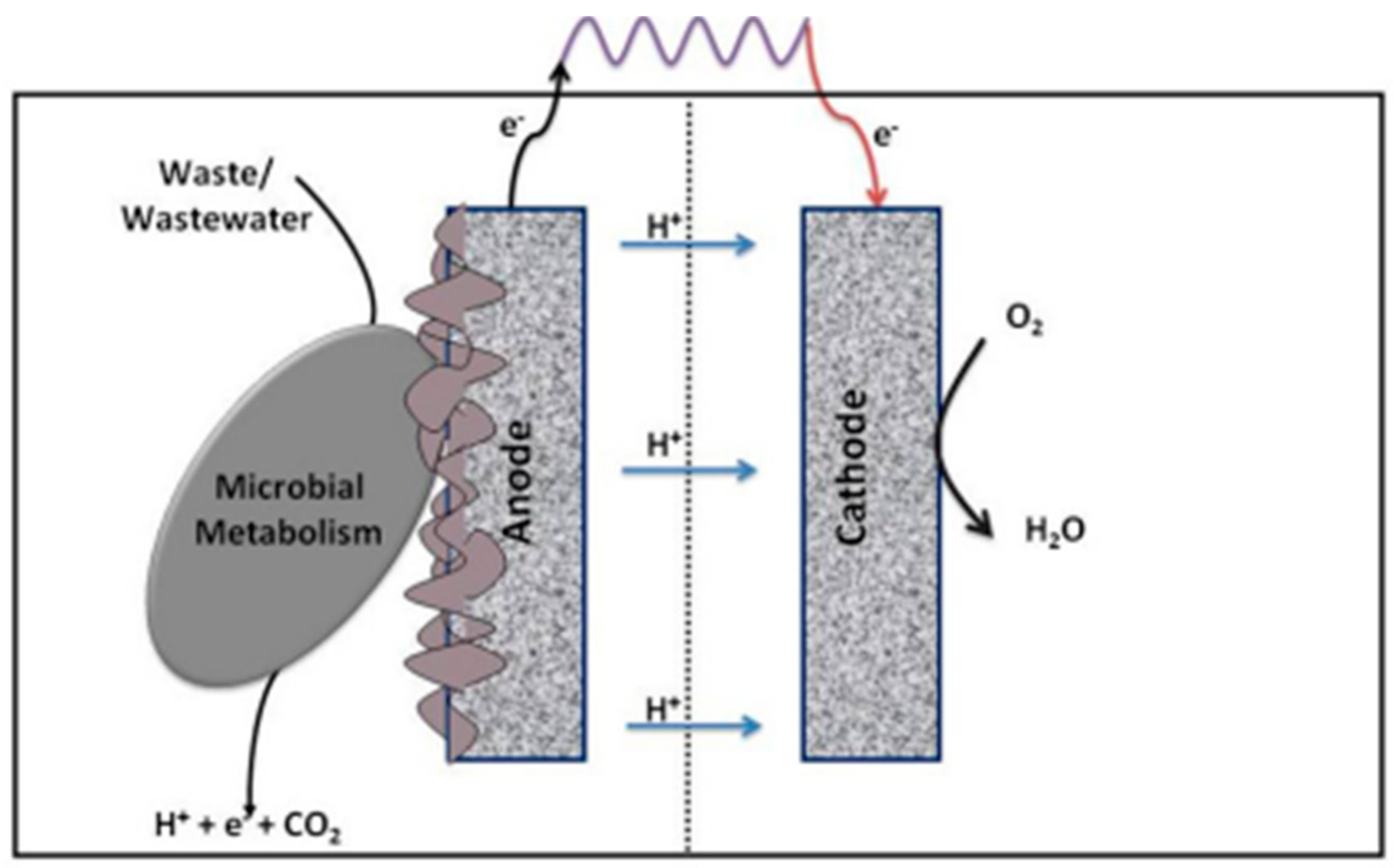


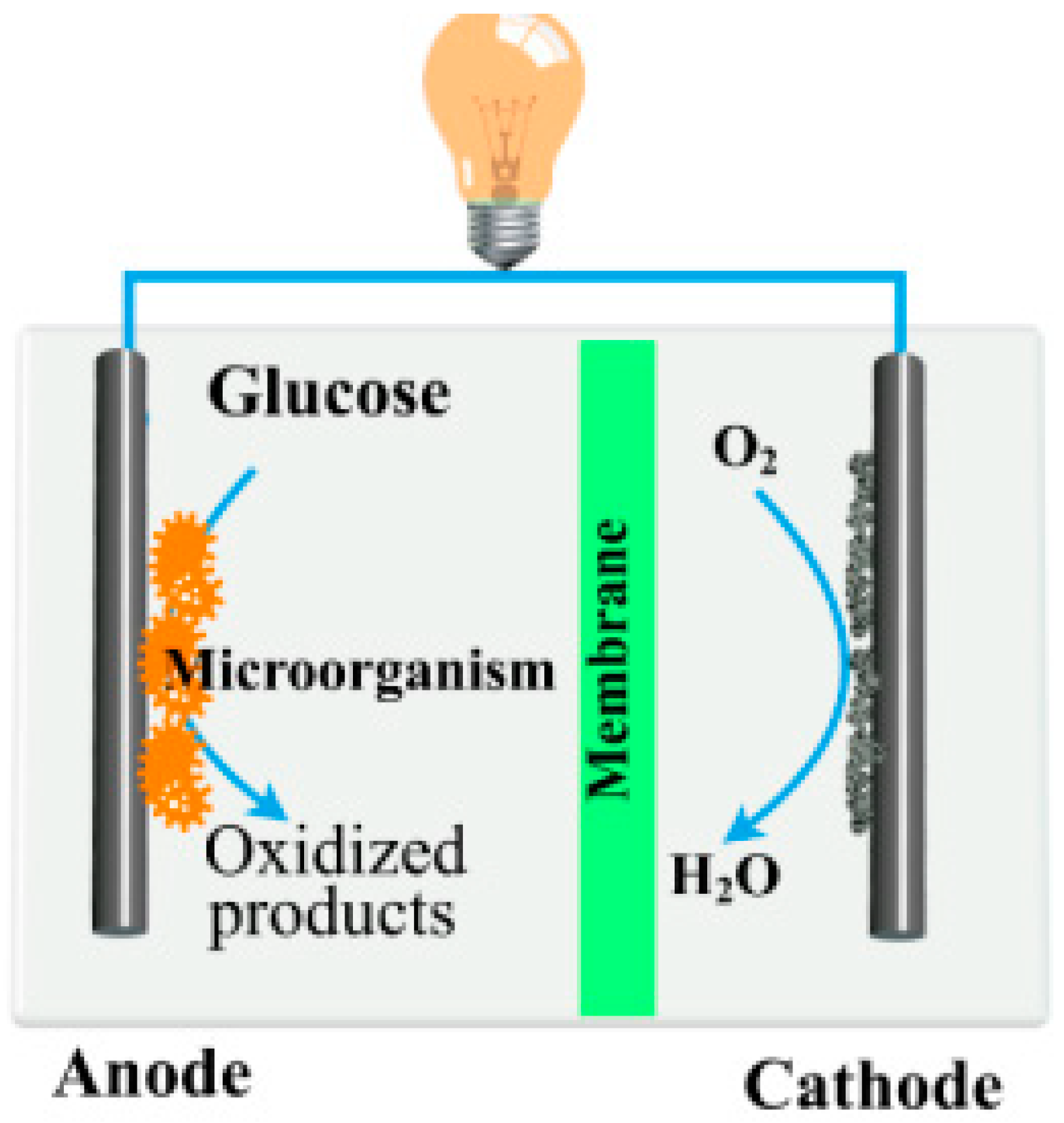
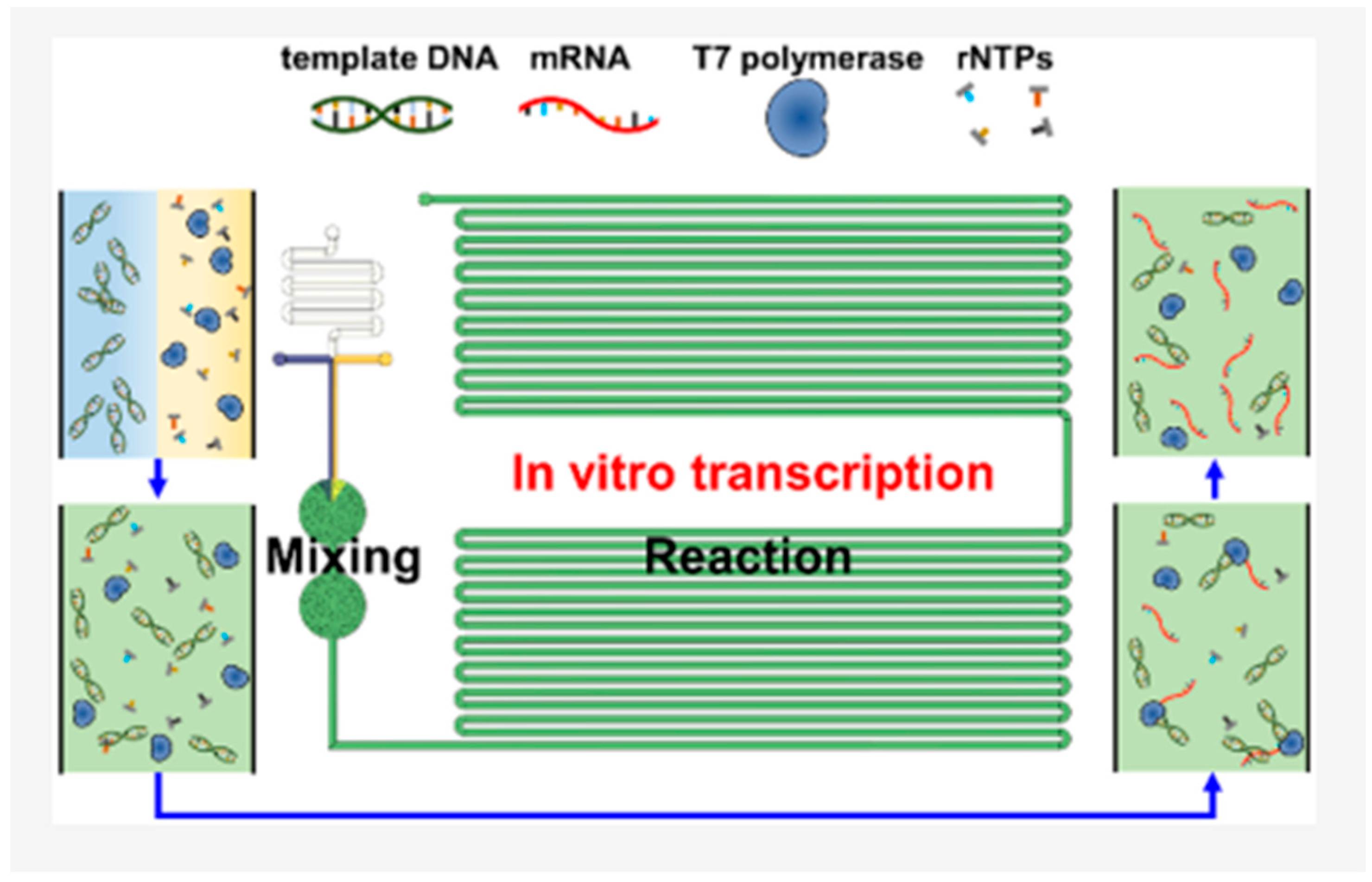
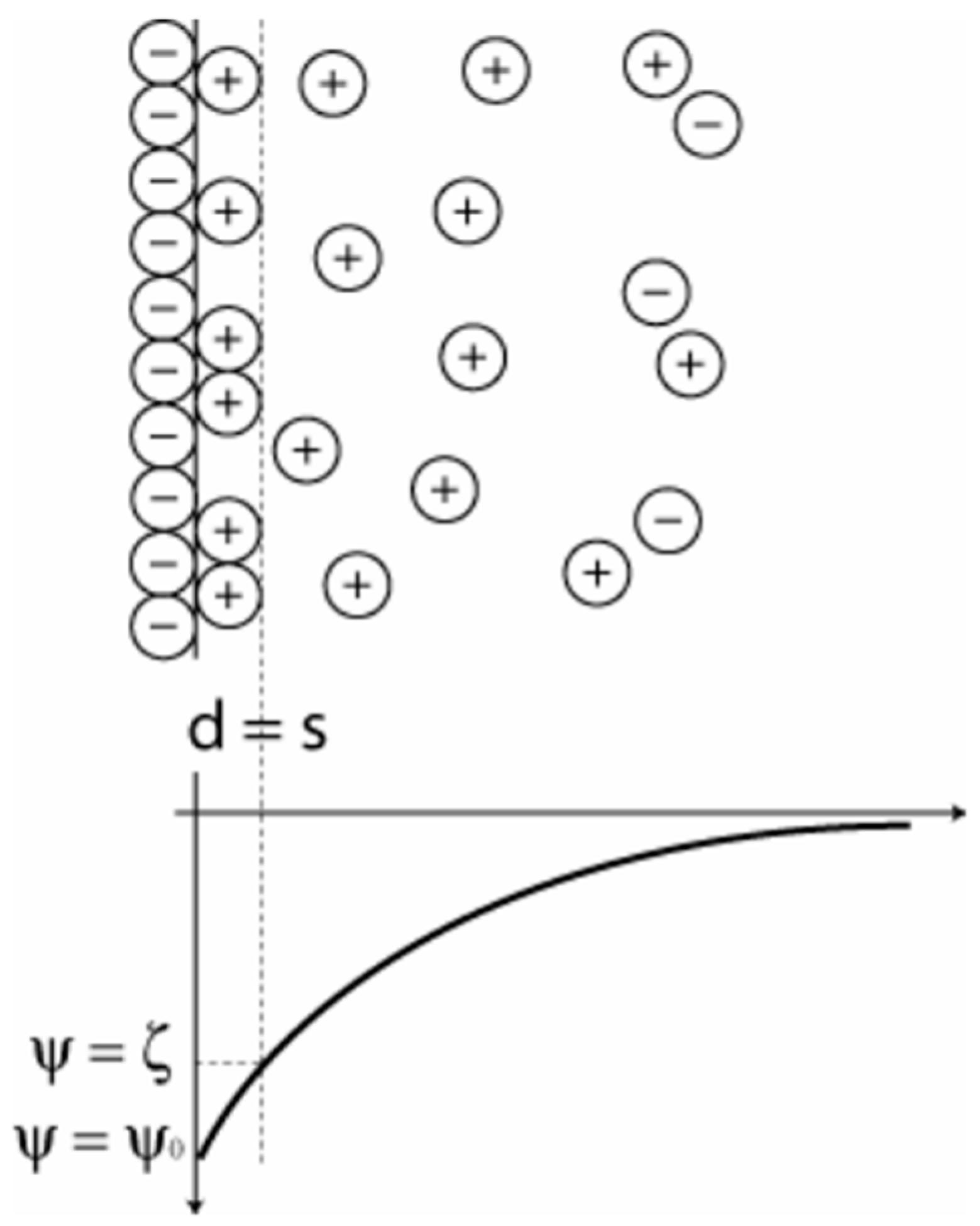
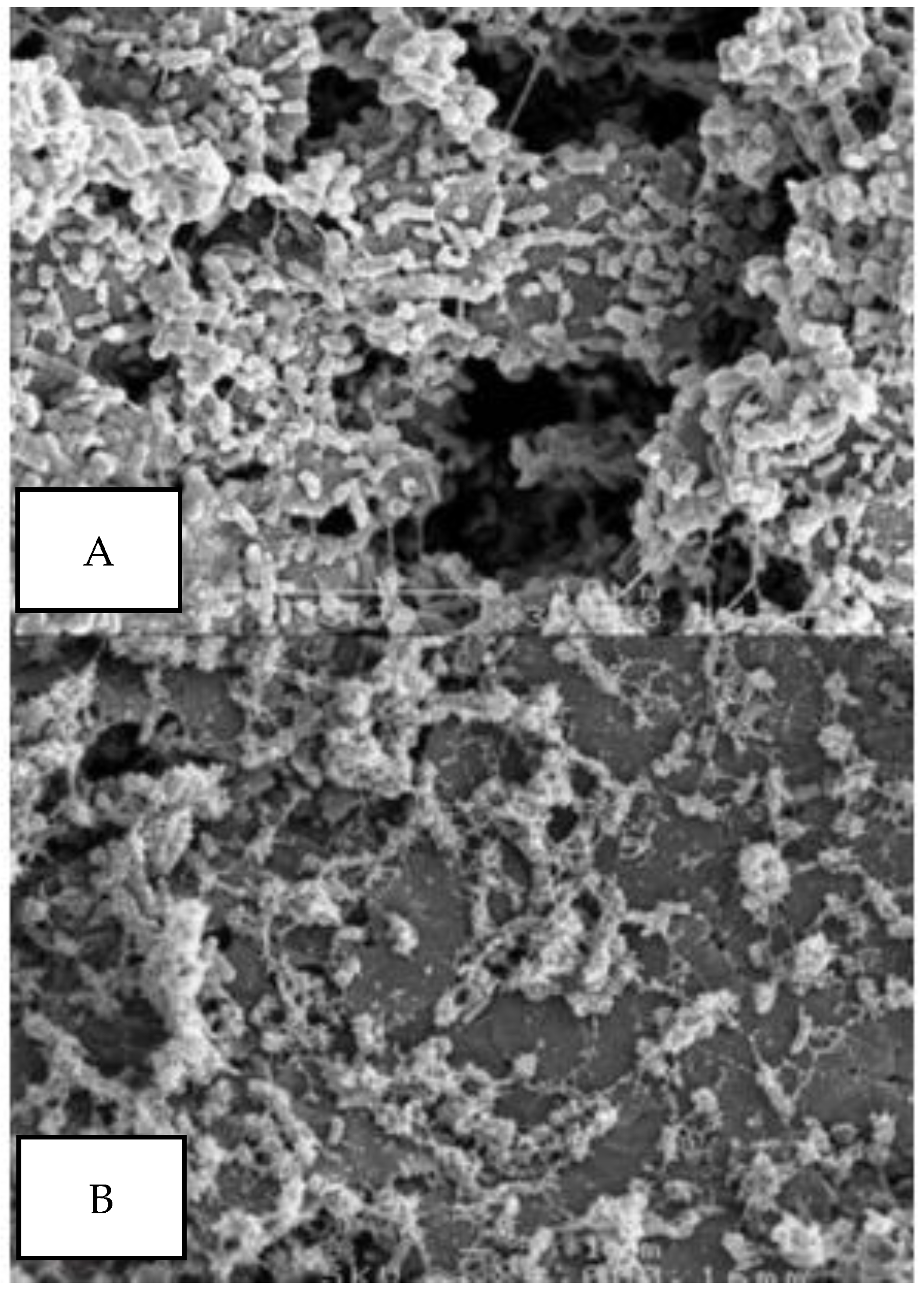

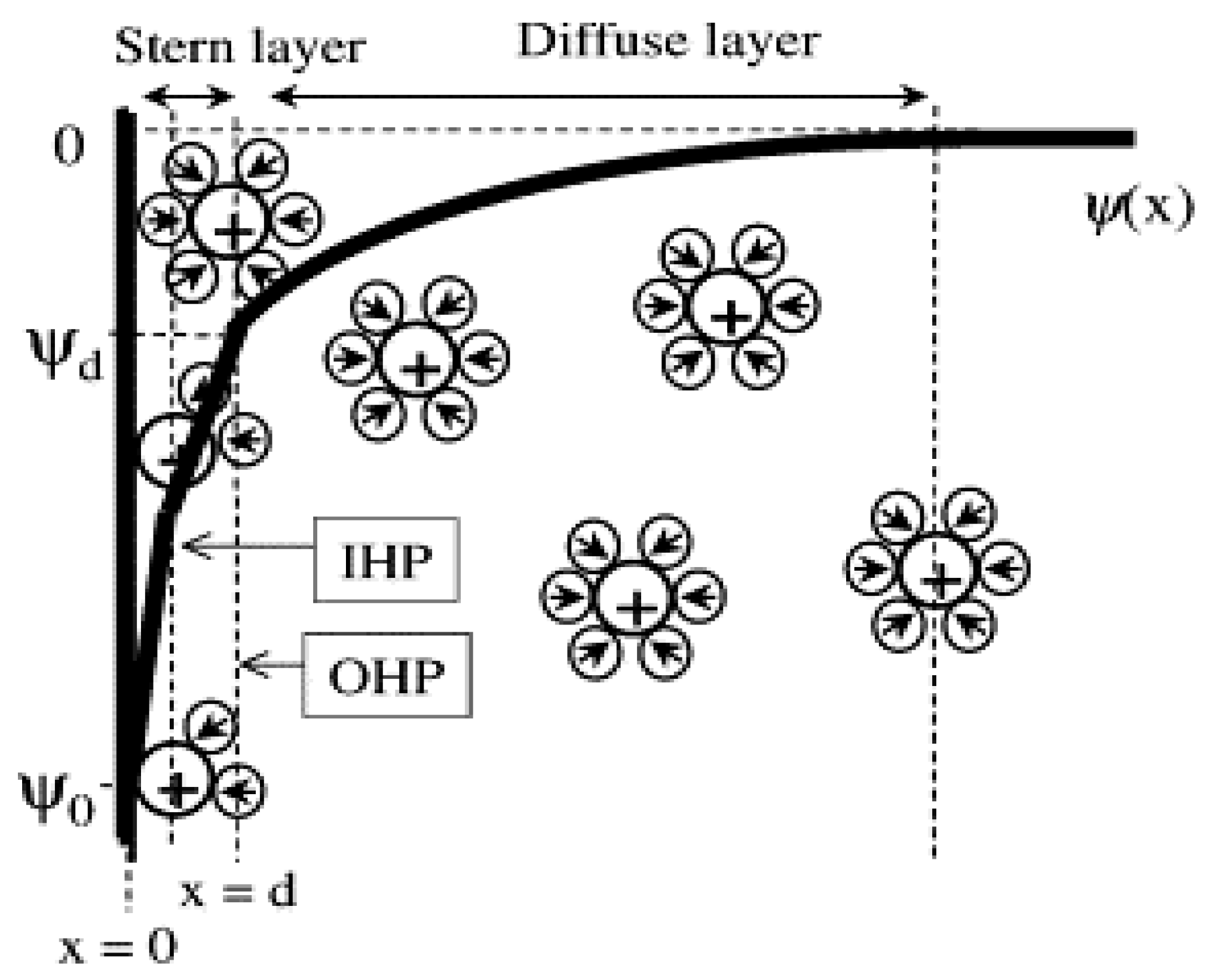

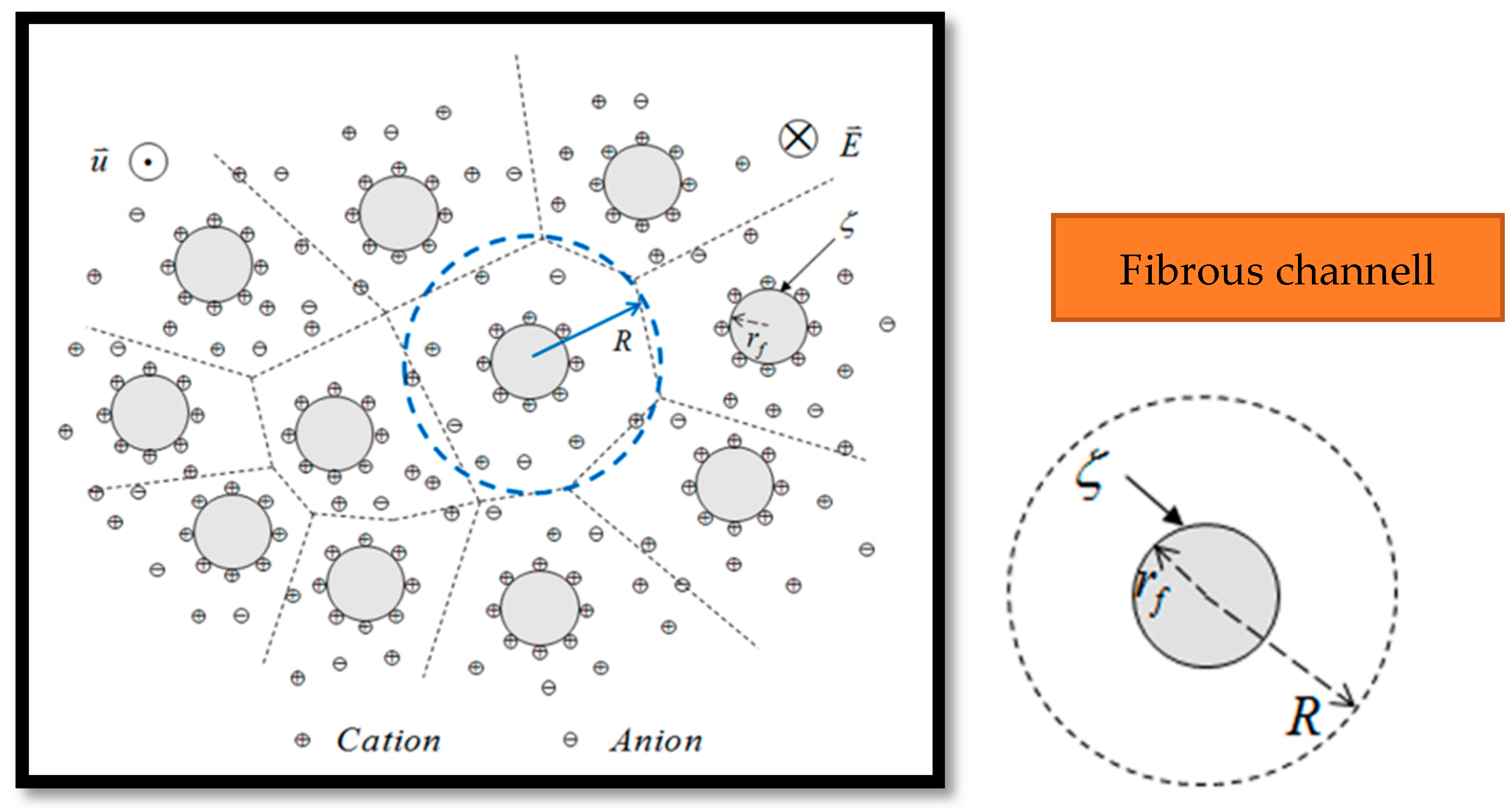

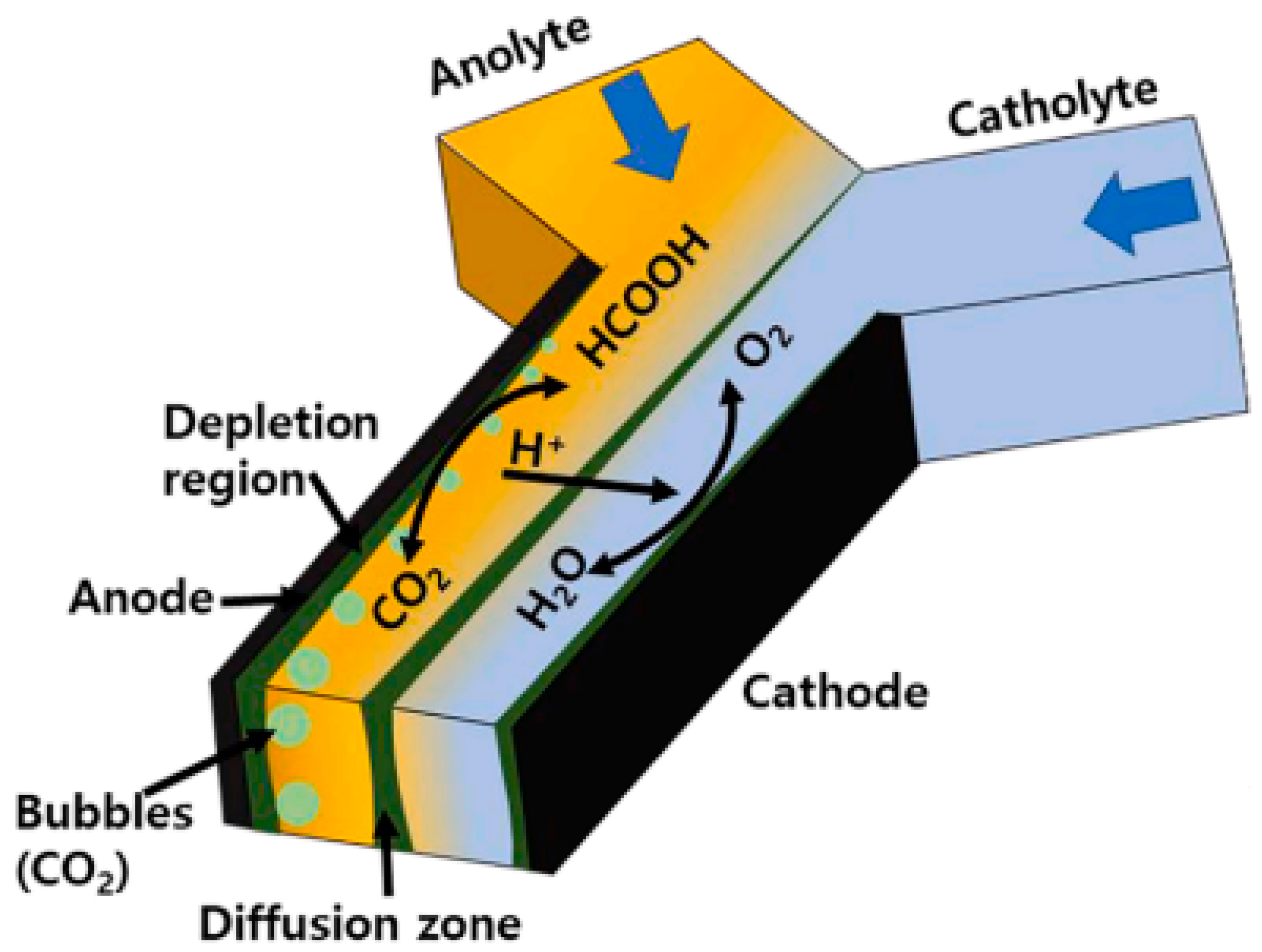

| Surface Reaction | Functional Group | Number Density |
|---|---|---|
| COOH⇔–COO−+H+ | Polysaccharide | 2.8 |
| Protein, peptidoglycan | Between 4.0 and 5.0 | |
| –NH3+⇔–NH2+H+ | Protein, peptidoglycan | Between 9.0 and 9.8 |
| –HPO4⇔–PO4−+H+ | Teichoic acids | 2.1 |
| –H2PO4⇔–HPO4−+H+ | Phospholipids | 2.1 |
| –HPO4−⇔–PO42−+H+ | Phospholipids | 7.2 |
Disclaimer/Publisher’s Note: The statements, opinions and data contained in all publications are solely those of the individual author(s) and contributor(s) and not of MDPI and/or the editor(s). MDPI and/or the editor(s) disclaim responsibility for any injury to people or property resulting from any ideas, methods, instructions or products referred to in the content. |
© 2024 by the authors. Licensee MDPI, Basel, Switzerland. This article is an open access article distributed under the terms and conditions of the Creative Commons Attribution (CC BY) license (https://creativecommons.org/licenses/by/4.0/).
Share and Cite
Amadu, M.; Miadonye, A. Interrelationship of Electric Double Layer Theory and Microfluidic Microbial Fuel Cells: A Review of Theoretical Foundations and Implications for Performance. Energies 2024, 17, 1472. https://doi.org/10.3390/en17061472
Amadu M, Miadonye A. Interrelationship of Electric Double Layer Theory and Microfluidic Microbial Fuel Cells: A Review of Theoretical Foundations and Implications for Performance. Energies. 2024; 17(6):1472. https://doi.org/10.3390/en17061472
Chicago/Turabian StyleAmadu, Mumuni, and Adango Miadonye. 2024. "Interrelationship of Electric Double Layer Theory and Microfluidic Microbial Fuel Cells: A Review of Theoretical Foundations and Implications for Performance" Energies 17, no. 6: 1472. https://doi.org/10.3390/en17061472
APA StyleAmadu, M., & Miadonye, A. (2024). Interrelationship of Electric Double Layer Theory and Microfluidic Microbial Fuel Cells: A Review of Theoretical Foundations and Implications for Performance. Energies, 17(6), 1472. https://doi.org/10.3390/en17061472





